Sunday, November 30. 2014
MacDonald: The latest campus fad, which sees racism everywhere, will create a new generation of permanent victims. Her article makes me feel unsafe as it seems to trivialize the feelings of the most vulnerable, marginalized, and irritable among us, such as me.
There is a book called Stop Walking on Eggshells: Taking Your Life Back but it's about dealing with mental illness.
Thanks, Bruce, for forwarding this fine speech by Archbishop Chaput, at Vimeo - Click it - it works
"Strangers In A Strange Land" featuring The Most Reverend Charles J. Chaput, O.F.M. Cap. from First Things on Vimeo.
Indeed, Christians are invited to be "in this world, but not of it."
1Therefore I urge you, brethren, by the mercies of God, to present your bodies a living and holy sacrifice, acceptable to God, which is your spiritual service of worship. 2And do not be conformed to this world, but be transformed by the renewing of your mind, so that you may prove what the will of God is, that which is good and acceptable and perfect. 3For through the grace given to me I say to everyone among you not to think more highly of himself than he ought to think; but to think so as to have sound judgment, as God has allotted to each a measure of faith.…
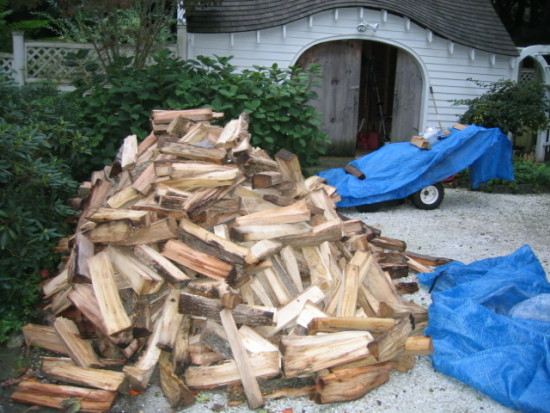
We have posted recently about firewood, green or dried.
Of course, it all depends on whether your fires are for pleasure, comfort, and ambience or for the BTUs. We have an old wood stove in the kitchen which provides tons of heat, but my fireplace in the den warms that little room up very effectively, to the point that I have to open the window.
Fireplaces do radiate heat, just much more ineffectively than stoves.
What wood to burn? Any wood is good. Some people are too afraid of burning fir and pine, but they are excellent, produce wonderful smells, and probably produce less chimney creosote than slower-burning hardwoods. However, if you keep a home fire burning as we do, you must have the chimney cleaned at least twice per winter, and ideally once per cord or two whatever the wood. Chimney fires are the reason so many churches and old houses have burned down in New England.
Generally speaking, the hotter the fire, the less creosote condensation in the chimney. Here you can read all about chimney creosote.
I have read that it takes a year to air-dry unsplit green wood, which can contain over 50% water when freshly cut (dry wood is around 25% water, depending on where you live). I burn green wood sometimes once I have a good bed of coals and don't want a blazing fire, but it certainly does not burn as hot as air-dried wood. I don't care because I am not reliant on wood for heat except when our power is down.
Here is some good firewood info from the Master Sweep.
Here are some good data about firewood
Info re the Franklin stove
Around this time (1744), the deputy governor of Pennsylvania, George Thomas, made an offer to Franklin to patent his design, but Franklin never patented any of his designs and inventions. He believed “that as we enjoy great advantages from the inventions of others, we should be glad of an opportunity to serve others by any invention of ours, and this we should do freely and generously”
Info re the Rumford Fireplace
Brick-lined chimneys? They are obsolete. Best thing is to line them with stovepipe.
Always bear in mind that every time you light a fire you are producing CO2, killing Gaia, and destroying the planet. Coal and oil, after all, are just very well-seasoned old wood. If you truly love Gaia, you would do without mechanized transport, or horses, or A/C, heat, and the internet.
Thursday, November 27. 2014
 it's a good opportunity to catch up on the local news. In Maine. it's a good opportunity to catch up on the local news. In Maine.
I see this morning that, during the night, Mrs. BD & Co. produced three punkin pies (from fresh pumpkins and homemade crust) and two pecan pies. Nice. My job this morning? Making stuffing (cornbread with sausage, onion and celery) and grilling the turkeys. Then the friendly Indians will arrive bearing their goodies after their annual TG 10 K race. I say they are nuts but they all blame me for introducing them to the running habit which I did, years ago. I quit that when my 3rd kid was born. It did not feel right to disappear for two hours every weekend morning with three little kids around.
Basting is a waste of time, the stuff just runs off the skin. With my frightening horse-sized hypodermic needle, I am injecting cider into the birds this year. Breasts, legs, wings, and under the skin. Once in the beginning, again when half-done. They are not Butterball, just plain fresh turkeys. One is 20 lbs and one is 26 lbs. That's a big turkey. Good leftovers for all. On the grill, I have plain charcoal and I am keeping some oak and apple logs burning and smoking on top of the charcoal. Nice smelling smoke wafting around for a country mile, as light snow falls. That's Yankeeland Thanksgiving. And the Indian Pudding is in the oven.
For a dumb reason, I did brine one of them for 24 hrs. in a ton of herbs and spices and wine, etc. but it really is not worth the trouble. Just inject them with liquids - sherry, white wine, cider, brandy, beer, or anything. You can add herbs, melted butter, whatever. It's a man's job, cooking meat and game. And mashing the taters with cream cheese, butter, sour cream, and heavy cream. Taste while doing to make sure you added enough pepper and to keep your strength up.
Wednesday, November 26. 2014
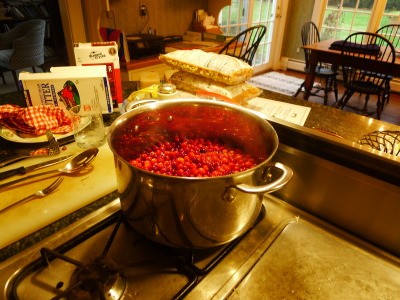 The Thanksgiving Recipes Googled in Every State - Which foods are unusually popular in each state on Thanksgiving. The Thanksgiving Recipes Googled in Every State - Which foods are unusually popular in each state on Thanksgiving.
It's wonderful to see how regionally-diverse this big nation of America remains, but I would not touch some of that stuff. I mean, Snickers Salad for Thanksgiving? Sheesh! Nothing against Snickers but oh, well, it's all good as long as we are grateful. I don't want to be a food snob, but, gee whiz, there are some limits!
Pic is my standard Yankeeland cooking. I use half the sugar, twice the berries. My mother in law always makes raw cranberry and orange relish - deliciously tangy and different from this.
Tuesday, November 25. 2014
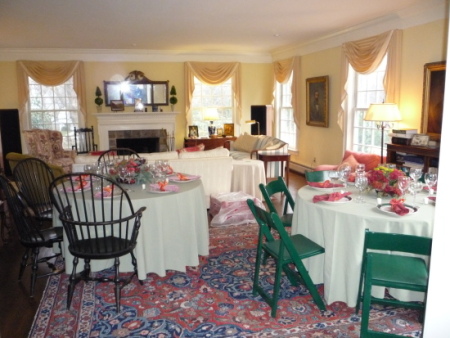
It looks like we're down to only 20-25 (not counting rug rats) of friends and family for Thanksgiving this year at the Maggie's Farm HQ. Some of my sibs are doing TG at their new vacation house on Cape Cod, appropriately-enough.
The way we do it is like the Indians did: everybody brings part of the feast. We rent a few round or long tables with chairs to put in the parlor, light up a couple of fireplaces, decorate things a little, and warm up the grill.
Best holiday of the year - no presents, just festive get-together. No TV allowed, generally-speaking.
Our home team is, as usual, providing 2 turkeys, stuffing, gravy, wine and beer, green salad, and Mrs. BD's pumpkin pies and Indian Pudding. Oh, and whipped cream. Soup is just too much trouble. Guests are bringing apple pies and ice cream, grilled brussel sprouts, pickled beets, sweet potatoes, mashed taters, mashed rutabaga, roasted parsnips, cranberry relish, champagne and Martinelli's, and hors d'oevres.
Low-carb, fat-free, vegan, and gluten free of course!
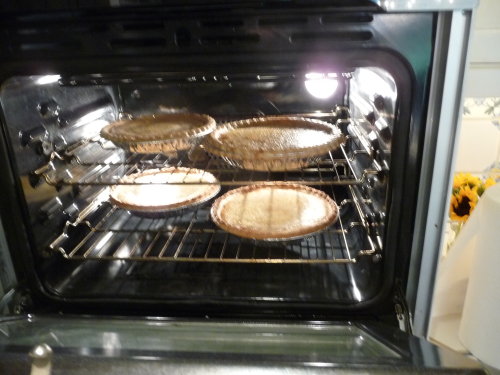
Sunday, November 23. 2014
You all know this already, but I just wanted to jot it down -
In the US, government has grown in importance as it has grown in power, in firepower, and in money. There was a time when nobody really cared about the federal government because it had no impact on daily life.
The Civil War, the Progressive Era of Wilson and Teddy Roosevelt, etc. changed all that. Government changed the culture. Over 100 years, government trained the masses to think "government should do something" whenever life presents them with obstacles, challenges, heartaches, bad luck, and expenses.
To win votes and to enjoy power, government decided to turn citizens into neo-serfs and to cement the impulse to turn to government instead of to God, to their own ingenuity, to family, to neighbor, etc. This infantilises people, weakens them, takes away their dignity.
Nowadays, everybody has his laundry list what government should do for them in their own interest. It is like a list for Santa. I want governments to do less and less.
Santa, keep your toys.
Saturday, November 22. 2014
This is a re-post:
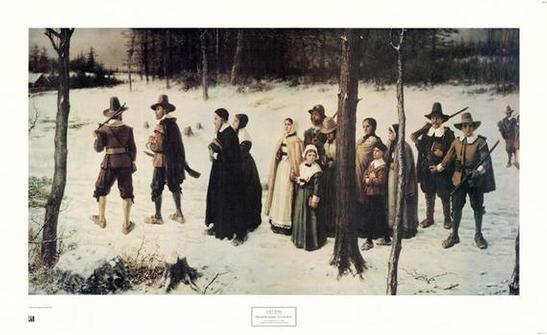
One historical detail I picked up in reading Philbrick's wonderful Mayflower is that the Pilgrims only permitted civil marriage ceremonies - no religion involved, and no preacher present.
As Calvinists, the Pilgrims/Puritans/Separatists of colonial New England viewed the Anglican sacraments as Papist, and thus representative of the Anti-Christ - and they meant it. As a consequence, Congregational Churches, the heirs of the Puritan movement, still have no sacraments per se, although many have liberalized (or backslided?) to the extent of doing baptism, communion - and, of course, weddings which, even if not technically sacramental, are viewed as sacred vows. People long for a touch of the sacred and sacramental.
It is fascinating to be reminded that our nation's deepest roots are in Calvinist theocracy: pre-enlightenment, for better or worse. They viewed the Indians as equals (though living in spiritual darkness), but they hung some Quakers in Boston as blasphemers (but mainly tried to just send them away).
They even hung an ancestor of mine, who ran away from her husband and kids in Kingston, Rhode Island and was caught on a trail outside of Boston, headed north. Her crime? She refused to return home. We suspect she was not overly fond of her husband, who had previously been suspected of throwing his first wife overboard on the way to Rhode Island in 1640.
Friday, November 21. 2014
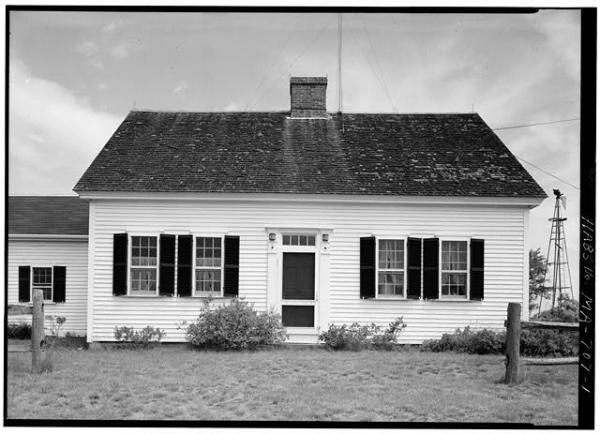
I have been perusing this out of print book: Truro - Cape Cod, Landmarks and Seamarks by Shebnah Rich (1888). I have a copy of the book, and wonder how in the world it got online.
Cape Cod began growing in European (English) population around 1630.
Farming and fishing were the main occupations. The soil was rich then due to the old forests. Today, there is no topsoil left. By 1750 there were few trees left on the Cape due to lumbering, land clearing for farming, and for fuel. The scrub oak and pine that predominate today is not the tall virgin hardwood forest that the colonists encountered.
Everybody grew things and raised animals. There was not much cash except from fishing and boat-building, and there were no shops. Main subsistence crops: orchards, maize, pumpkin and squash, root vegetables, beans, rye. No wheat, no flour, no sugar unless very wealthy - but there was molasses from the West Indies. Also, pigs, steer, milk cows, chickens, and horses for transportation. Cranberries, raspberries, blackberries, and blueberries grew wild. There were plenty of deer and rabbits too, and of course abundant shellfish. Beans with a little pork was a standard meal. People baked their bread once a week, made of mixes of corn (maize) and rye flour. Food: Early American food and drink
When you slaughtered a hog or steer, you shared the meat with neighbors. They did the same.
You were allowed to shoot a wolf or a "problem Indian" but the Indians were not much of a problem and soon settled into Indiantowns and learned English. King Philip's War was not a big deal on Cape Cod.
A village Meeting House served many purposes including local government meetings and church. Most of the early congregations were "united," ie Methodist and Congregational worshipping together. In the early days there was a hot market for pastors and Harvard began grinding them out in 1636 to meet the demand. Like the Boston colonists, the Cape Codders were not Puritans like the Plymouth group.
Other than local rules made in town meetings, there was no "government" in evidence at all. Town officials were by vote, and volunteers. There were no police but there were informal militias. Every adult male citizen was required to own a firearm (mostly matchlocks). Later on, recruiters would pass through towns demanding recruits for the French and Indian War. The structure of grammar schooling varied widely from village to village.
Truancy from church was a crime. So was swearing. Sunday church services generally had two one-hour sermons and around an hour of prayer. The service was around four hours in all. No music, of course, and no communion. Those were Papist things. Each church had a guy assigned to wake up drowsers with a long stick with a feather on one end (for the ladies) and a knob on the other end (to conk the drowsy men on the head). A fun task, no doubt.
Thanksgiving: There were fall harvest Thanksgiving feasts all over the Cape. Nothing to do with the original Pilgrims, just a traditional harvest time thanks to God. The Pilgrim Thanksgiving? They had very little to be thankful for with half their group dead in that first winter, but they were anyway. Remember, they were headed for the already established town of New Amsterdam (New York), not Massachusetts. Got blown off course.
There were windmills all over the Cape, very early. Their main purposes were making corn or rye meal, or for filling up salt flats for salt production (to make salt cod).
Fishing meant mostly Cod on George's Bank, but later Mackeral too. Some guys were fishing schooner skippers by 25. Some of them went on to be transoceanic ship captains. There was some near-shore whaling, and the occasional stranding of a pod of Blackfish (aka Pilot Whales) was hitting the jackpot.
Alcohol: Cider.
Death: Mainly infectious diseases of early childhood. Some TB in young adulthood. Also, puerperal fever killed a lot of wives so men often went through a series of them. After that, fishermen drowning was the main cause - which provided widows for the widowers. If you escaped those things, most people lived into their 80s. (Those childhood death rates and accident death rates are what skews old-time life expectancy data and thus the averages are meaningless.)
Illumination and heat: Fireplaces for heat, and one in the kitchen for cooking. Wood stoves came much later. Bayberry candles, whale oil lamps.
Transportation, etc: Roads were terrible. Transportation was mainly by water and to be a town you needed a harbor. With its fine harbor, Provincetown was the largest on the Lower Cape. Early on, there was regular travel and mail, via Boston packets.
We might consider these settlers poor and deprived, but all they saw was abundance, faith, and hope. Life was hard and highly uncomfortable (by our standards), and was expected to be. You fended for yourself. If judged utterly helpless, the church came to your aid.
Housing: The history of colonial housing is an interesting one, mostly borrowed from England and from Holland in areas around New York. However, the rural Cape Cod cottage was an American invention and typical on colonial Cape Cod. No plumbing. Every village had an amateur post and beam carpenter in an era where most trades were amateur and everybody was a farmer, including schooner skippers, pastors, and doctors.
Photo on top is the Jonah Atkins house, Truro, Mass.
Thursday, November 20. 2014
Silly me, thinking that illegal immigration was against the law rather than being rewarded. A few links:
Immigration Lawyer: Obama’s Plan Is ‘Like The Golden Ticket’
Christian Adams: Obama, Our Modern John C. Calhoun
I never learned in school that a president can make his own laws whenever he is frustrated by Congress, but the NYT says it's ok to do that. I can easily imagine what they would say with a Conservative pulling something like that. Anyway, what's the urgency?
Krauthammer: Obama executive action on immigration is 'outside of his power'
Or even for ordinary peoples' interest, there is a book: Far From the Tree: Parents, Children and the Search for Identity by Andrew Solomon:
Solomon’s startling proposition in Far from the Tree is that being exceptional is at the core of the human condition—that difference is what unites us. He writes about families coping with deafness, dwarfism, Down syndrome, autism, schizophrenia, or multiple severe disabilities; with children who are prodigies, who are conceived in rape, who become criminals, who are transgender. While each of these characteristics is potentially isolating, the experience of difference within families is universal, and Solomon documents triumphs of love over prejudice in every chapter.
Wednesday, November 19. 2014
Apparently, it is a protected opinion against religion and thus religious in some sense: Atheists and Secular Humanists are protected by the First Amendment regardless of whether their belief systems are “religions” or not.
It is legally interesting, but in my experience most atheists have faith in some thing or some things as a life foundation, mainly pagan or materialist sorts of things. In the US, most atheists live on a Christian foundation.
The Real Roots of Midlife Crisis - What a growing body of research reveals about the biology of
human happiness—and how to navigate the (temporary) slump in middle age. A quote:
“I think it must be something internal,” my 45-year-old friend S. told me. He described his 20s as exciting and fun (“I was really dumb but thought I knew a lot”) and his 30s as a time of hard work and steady rewards (“I felt on track … Things looked like white picket fences and the American dream”), but said he was bushwhacked in his 40s by an unexpected divorce, unmarried fatherhood, and a heart attack. He said he now experiences difficulty feeling contentment, leading to some of the same self-doubt that I felt: a creeping suspicion that he is fated to be whiny. He also wondered whether his dissatisfaction has been a cause of some of his problems, not just an effect. “Professionally, things looked pretty good,” S. told me. “But maybe something was going on. Something sufficient for my wife to leave. If I did a deep psychological dive, I might say that nothing will ever make me content. Maybe there’s something deeply psychologically wrong with me. I see life as a challenge to overcome rather than an adventure to be enjoyed. I’ve thought of running away to Brazil—changing my name and becoming a hotel clerk. Maybe that will change in my 50s.”
On reading about this piece, I found myself wondering about the premise of the questions in the surveys. A question like "How satisfied are you with your life these days?" seems like a very American question to me. Most people on this planet think about whether they are satisfied by their meal, or whether their god is satisfied with them, and all sorts of other things other than narcissistic or hedonistic satisfaction.
Tuesday, November 18. 2014
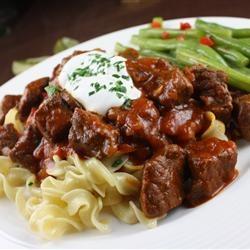 It can be simple or complex. Here's simple. It can be simple or complex. Here's simple.
Classic way to serve it is with spaetzle, a dollop of sour cream on top, and a side of sliced cucumber and onion marinated in vinegar.
Monday, November 17. 2014
The gigolo industry is gradually coming out of the closet: Male escorts - Is the growing market for male escorts a sign of female sexual liberation or just a re-run of the same old stereotypes?
This has nothing to do with "liberation." Women have always had healthy sex drives, but just kept quiet about it. The illusion of genteel innocence can be sexy to men. On the other hand, the image of dirty, nasty and accessible femininity can be sexy to men too. Almost anything can be sexy to men. Despite modern lesbian feminism, men should never underestimate female sexual longings and fantasies. Female fantasies are at least as reckless as those of men.
Women are, perhaps, more discriminating than guys but their needs for sex are abundant, especially in middle age. Perhaps Mother Nature wants us to get knocked up before it's too late.
Last day on the beach. Florida, east coast.
Relaxed and enjoyed the sound of waves, played dominoes with the in-laws, ate fish every day, did some surf-casting (caught plenty, but nothing big enough), read my book (The War That Ended Peace by Margaret MacMillan), and today I'm going kayaking or paddle-boarding. If I can, paddle-boarding, it's better for your core. But either is a good workout.
I had blackened lane snapper last night at a restaurant that didn't appear to be more than a hole in the wall, probably the best I've had. Sometimes it's best not to judge based on the superficial appearance. We had breaded hogfish the night before, at the in-laws'.
Flight home tomorrow in the early morning. This is the second year I took a mid-November vacation. It's a good time to go south. Not only do you stay warm when the rest of the country is chilling, but you get two shortened workweeks heading into Thanksgiving. Then you roll right into the Christmas holiday season.
(Late note: We went paddle-boarding and learned a valuable lesson. Pay attention to the wind. Our trip north up the Indian River, I barely dipped my paddle thanks to the wind. I realilzed this would pose some difficulty for the return. In fact, we had to climb out and carry the boards for some stretches. Thankfully, they are not heavy. Just as thankfully, the Indian River is not too deep along the shore and mangroves, so we could wade if necessary. One thing about paddle-boarding, even if you're not paddling, you get a workout. Keeping your balance is tricky if you're not used to it. I got a mighty scare when I passed over a tarpon, who didn't take kindly to our presence.)
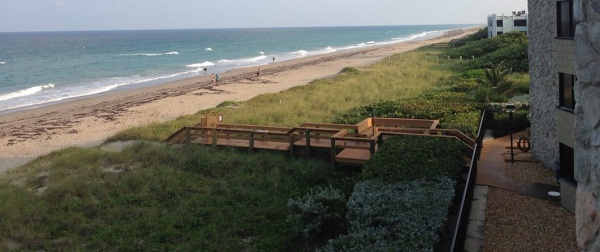
Sunday, November 16. 2014

What I am reading now - judge me if you must, but be gentle because there is too much of our culture to keep up with, and it is up to each of us, as a duty, to contain and to transmit all of it that we can. Duty.
The Geography of Nowhere by James Kuntsler (the first half is better than the second)
The Cave and the Light: Plato Versus Aristotle, and the Struggle for the Soul of Western Civilization by Arthur Herman
Jesus on Trial: A Lawyer Affirms the Truth of the Gospel by David Limbaugh (it's ok, not great but raises plenty of interesting issues to talk about)
The Salt book: Lobstering, sea moss pudding, stone walls, rum running, maple syrup, snowshoes, and other Yankee doings (a good deed to write all that stuff down)
Things That Matter: Three Decades of Passions, Pastimes and Politics by Charles Krauthammer MD (delightful - can't help but admire that fellow)
On my to-read pile:
The Ruby in her Navel by Barry Unsworth
The Real Nature of Religion by Rebecca Bynum
Traces Of The Past: Unraveling The Secrets Of Archaeology Through Chemistry by Joseph Lambert
Saving Normal: An Insider's Revolt against Out-of-Control Psychiatric
Diagnosis, DSM-5, Big Pharma, and the Medicalization of Ordinary Life by Dr. Alan Francis
Your God is Too Small by J. B. Phillips
The Pain Chronicles: Cures, Myths, Mysteries, Prayers, Diaries, Brain Scans, Healing, and the Science of Suffering by Melanie Thernstrom
The Long Ships by Frans Bengtsson
Books maybe of interest:
The Joy of Automotion: Musings From a Vehicular Dilettante by Dale Franks
Where Have You Been?: Selected Essays by Michael Hofman
The Liberal Arrogance at the Core of Obamacare:
...paternalism is warranted, they argue, because without the government, people would fall prey to big, bad corporate interests and their efforts to relentlessly maximize shareholder value.
Thus, Obamacare is all about the federal government making decisions on behalf of Americans because -- as Gruber and his liberal brethren would argue -- the people are unable or unwilling to make the choices that elites believe advance the social good. That’s why President Barack Obama and his Democratic allies in Congress invented the mechanisms in the law that, for example, transfer resources from those who are young and healthy to those who are old and sick.
I don't think that I am unique in preferring big bad business interests to big, bad crony government and political interests. If you don't like a business, you can quit it. Not so easy to quit an armed government.
Being American is not supposed to be being a US subject.
Related: Gruber is an honest Liberal because he admits to grubering. Seems to me that his confessions are just bragging.
A new word: "Grubering." Lying your ass off to make a better world for you pathetic idiots.
Friday, November 14. 2014

We posted about Tarte Tatin last week, and there is no need to post more about Apple Pie because everybody makes it the way their Mom did. Here are more favorite apple desserts, all quick and easy to make (except for the Apple Tart), and all as American as Sarah Palin (except for the Apple Tart):
Apple Brown Betty (a classic American colonial dessert - a "betty" is a pudding)
Apple Cobbler (I think it's better with a few cranberries added)
Apple-Cranberry Crisp
Apple Crisp (a Dr. Bliss standard, with ice cream)
Apple Dumpling
Baked Apples
Apple Tart
Apple Pan Dowdy
I also like to make Apple Pancakes for breakfast. I just throw thin slices into the batter. A good pancake combo is some apple and a handful of cranberries. (Every fall I throw a dozen or so bags of cranberries in the freezer. They seem to last 10 months easily without any deterioration.)
Our Editor tells me his family refers to all of these apple desserts generically as "Upside-down Apple Town Dowdy Betty Bow Wow," and reminds our readers that, in Yankeeland, Apple Pie is traditionally for breakfast, not for dessert.
Common Core–The Elites Did It:
The broad view is that the Common Core didn’t grow out of grassroots demand for curricular reform. It isn’t the work of school boards or an initiative put in motion by dissatisfied parents. It didn’t come about because good teachers convened and came up with a proposal to improve K-12 education. It was instead the product of a handful of very-well connected intellectuals who dreamed up their own vision of what American schools should do.
and
One of the local realities is that many parents who are actively involved in their children’s education view the Common Core as state-imposed disaster. They are immune to the Coleman-Gates appeal for uniformity of teaching for the sake of uniformity itself. They are suspicious of an approach to math that vaults over tried-and-true approaches for the sake of the unproven benefits of a new “theory.” They are equally perturbed by an approach that derogates the importance of literature and, when it does introduce literary works, chops them into fragments and short extracts.
Combine arrogance, money, fancy degrees, and a top-down attitude, and this is what you get: a one-size-fits-all central plan designed for the masses by our moral and intellectual superiors whether you want it or not.
Same general philosophy as Obamacare. Or this: Liberal Masterminds Demand National Food Policy. No, that's not from The Onion.
Thursday, November 13. 2014
From Violence is Golden:
A rule not ultimately backed by the threat of violence is merely a suggestion. States rely on laws enforced by men ready to do violence against lawbreakers. Every tax, every code and every licensing requirement demands an escalating progression of penalties that, in the end, must result in the forcible seizure of property or imprisonment by armed men prepared to do violence in the event of resistance or non–compliance. Every time a soccer mom stands up and demands harsher penalties for drunk driving, or selling cigarettes to minors, or owning a pit bull, or not recycling, she is petitioning the state to use force to impose her will. She is no longer asking nicely. The viability of every family law, gun law, zoning law, traffic law, immigration law, import law, export law and financial regulation depends on both the willingness and wherewithal of the group to exact order by force.
When an environmentalist demands that we “save the whales,” he or she is in effect making the argument that saving the whales is so important that it is worth doing harm to humans who harm whales. The peaceful environmentalist is petitioning the leviathan to authorize the use of violence in the interest of protecting leviathans. If state leaders were to agree and express that it was, indeed, important to “save the whales,” but then decline to penalize those who bring harm to whales, or decline to enforce those penalties under threat of violent police or military action, the expressed sentiment would be a meaningless gesture. Those who wanted to bring harm to whales would feel free to do so, as it is said, with impunity — without punishment.
Without action, words are just words. Without violence, laws are just words.
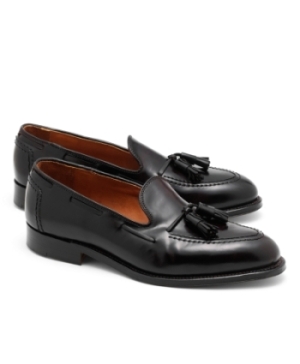 I'm talking about good casual leather shoes and boots, and dress/dress work shoes. "Casual," of course, is relative. I'm talking about good casual leather shoes and boots, and dress/dress work shoes. "Casual," of course, is relative.
Well-made examples of these should last a lifetime, and often would except that our feet increase in size somewhat with age (due to gravity).
If cheap shoes are disposable items, that's one thing, but $300-$500+ men's shoes deserve some attention and the custom-built deserve the most, for sure (for example, John Lobb's custom leather shoes cost as much as a lady's fancy handbag).
Guys with fancy jobs wear $1000+ shoes, but I would die first. Lady footwear is beyond my ken, but I overhear things about it from my daughters and it sounds insane to me. With the cost of appropriate womens' shoes you need to be a Saudi to afford your harem. (We had a fun time last year waiting in the Milan airport while Mrs. BD identified the multi-thousand dollar shoes under the black burkhas.)
Hard-work shoes, hunting boots (if resole-able) and athletic shoes (which you throw out when worn out) are different topics.
- Everybody knows that you should never wear the same pair of nice shoes two days in a row. They do not get time to dry out from your foot sweat. I often ignore that rule out of laziness.
- New shoes, I am told, should be polished and maybe waterproofed before wearing.
- Waterproofing is not a bad idea, does not damage or discolor leather (but mink oil does).
- If your feet expand a bit and you want to keep the good old shoes with the patina of age, shoe stretchers do work.
- Rule of thumb (for men's and women's footwear) generally speaking, I think, good shoes are not noticeable except to women and to gay guys but bad or ugly shoes are, and make a bad impression. You have to be either very rich or very powerful to get away with wearing bad or inappropriate clothing.
- Cleaning and shining are not just for appearance. They are for endurance. Pros do a better job (your local shoe man, or those guys in Grand Central Terminal if you ever pass through there and have a spare 20 minutes). It can be a good exercise to do it yourself: The Perfect Shoe Shine
- Good source for shoe care stuff: Shoe Care Supplies.com . Paste stuff is better than the hard waxes, it seems to me. It doesn't take much. The challenge is matching the colors.
Pic is Brooks Brothers' cordovan tassel loafers - for some people they are casual weekend shoes, and for some - like me - they are more like dress shoes but my life does not require dressy tie shoes altho I have one or two. That applies up here in Yankeeland and the Northeast US, anyway, where lizardskin boots would be an affectation and Ralph Lauren things are for wannabes. Choice of dress in general, besides appropriateness and just plain "what you are comfortable with", is part of tribal identification and signaling, like Indian headdresses.
More random shoe topics -
Most comfortable shoes for men and women? Definitely Mephisto. They might not be proper for high-level white collar work, but they are, by far, the best for comfort.
Preppiest shoes? List here. Lots of guys like the horsebit loafers but I do not.
Wednesday, November 12. 2014
Our urban hike just won't go away. Yesterday, Bird Dog posted pics of Trinity Church. Today I'm posting one location we didn't happen to visit. It was on the original agenda, by the time we got to Washington Square, taking a swing west would have added too much time to the walk. Spirits were high, but it seemed too much to ask. There's always next year.
As a young arrival in New York, I was single and had small amounts of cash to spend on entertainment. There were plenty of ways to find that entertainment at South Street Seaport, midtown in some of the (much more expensive) watering holes, Greenwich Village, and even portions of the West Village. In particular, The White Horse Tavern (warning - the full article, if you wish to read it, requires joining the site, but there is plenty in the portion I've linked to) was one of my favorite places to go after work on Thursday and Friday. For some reason, I never stopped in on the weekends.
Continue reading "The White Horse Tavern"
 I post enough recipes that I like, and that I like to make. It's your turn for the most American of foods. I post enough recipes that I like, and that I like to make. It's your turn for the most American of foods.
What are your favorite Apple Pie recipes? Got any tips?
A pal of mine likes to sprinkle sugar over the top crust partway through the baking. He uses supermarket crusts, but it works very well.
(I actually like Tarte Tatin better, but have trouble caramelizing the bottom - which becomes the top.)
Our Maggie's Farm chef, in photo, will test each one of them for us.
I thought I had deleted my NYC Urban Hike pics of Trinity Church, but I found them. This one is the third Trinity Church that was built (completed 1846 so it's not very old - but the graveyard is).
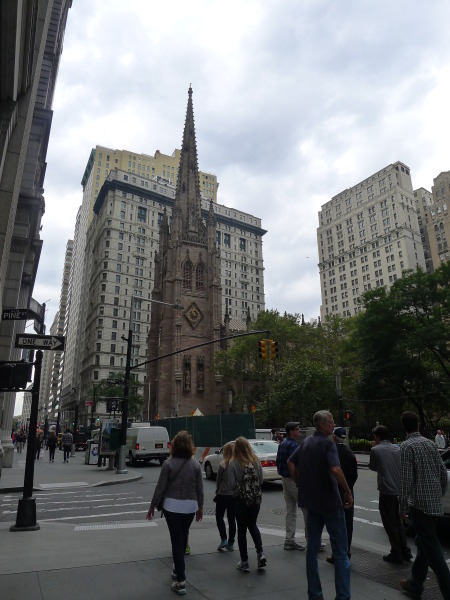
A few more pics below the fold -
Continue reading "NYC's Trinity Church"
|


 it's a good opportunity to catch up
it's a good opportunity to catch up 

 It can be simple or complex. Here's
It can be simple or complex. Here's


 I'm talking about good casual leather shoes and boots, and dress/dress work shoes. "Casual," of course, is relative.
I'm talking about good casual leather shoes and boots, and dress/dress work shoes. "Casual," of course, is relative.
 I post enough recipes that I like, and that I like to make. It's your turn for the most American of foods.
I post enough recipes that I like, and that I like to make. It's your turn for the most American of foods.